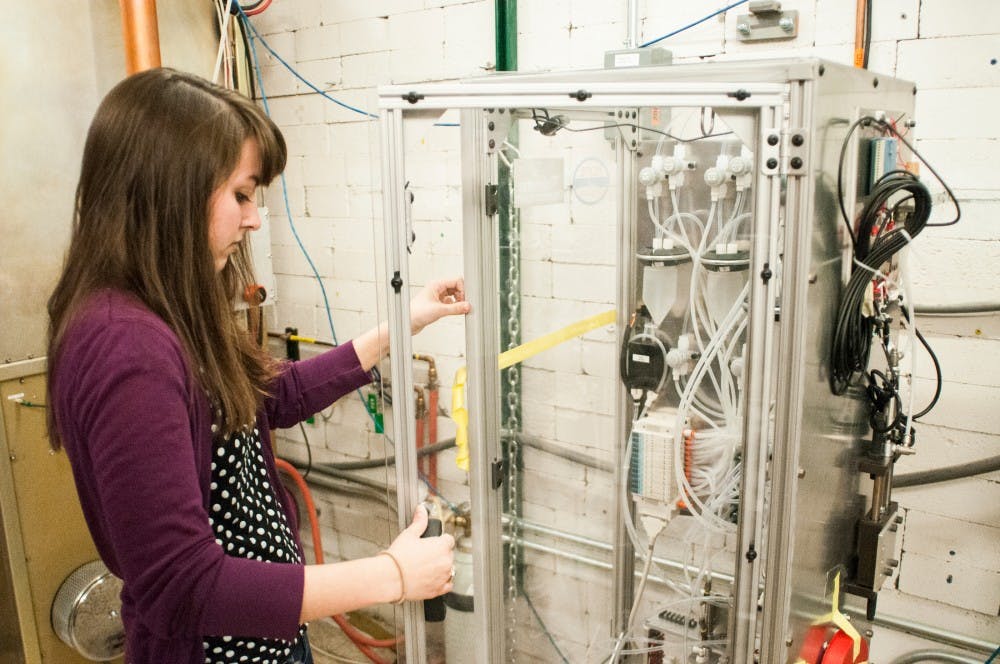
MSU is the top school in the country for nuclear physics, according to U.S. News and World Report, and the home of the Facility for Rare Isotope Beams, or FRIB, a research facility that impacts the Michigan economy by bringing in jobs and students to the area with opportunities and advancements.
“FRIB really is going to be a world-renowned facility,” Chris Sullivan, a fifth-year graduate student who works at the FRIB, said. “I was just in a conference this last summer in Japan and it was a conference about nuclear astrophysics, we’re trying to better understand what the origin of all the elements are, and almost everybody was talking ... about how FRIB is known for our isotope beams and little East Lansing and Lansing, Michigan is going to be a game changer in actually solving this problem of where the elements originate.”
According to a study released by Director of the Center of Economic Analysis Steven Miller, the FRIB, located at the National Superconducting Cyclotron Laboratory, or NSCL, is creating an economic impact in measurable dollar returns.
“It’s hardly necessary that every state or public investment make a payback, but this is one of those cases where the state investment in this project actually returns more to the state government in actuated cost,” Miller said. “It’s generating $205 million in tax revenues over the course of the 32 years versus the $95 million that went into it.”
One of the ways jobs and advancements are affected by MSU’s FRIB is in medical applications, for example MRI technology that would otherwise not be possible without public investment.
“There was one application with the cyclotron that those isotopes actually go into a process that is used in medicine,” Miller said. “And that’s one of the key areas where we would see the commercialization of the outcome from the FRIB. Other areas are possible, the sky is the limit.”
When harvesting isotopes from leftover beams used in experiments, first-year graduate student and FRIB employee Paige Abel said some of the isotopes go toward medical applications, the most well-known being PET imaging technology. Hospital PET scans can be used to detect cancers, but current research is going toward more targeted therapy.
“PET scans are currently being done with radioactive isotopes,” Abel said. “But the therapy for cancer is still heavily under research, so that would be a really helpful thing about being able to harvest these isotopes because the research is ongoing.”
Abel works in one of the different research groups available for graduate students at FRIB, ranging from experimental to theoretical, either chemistry-oriented or physics-oriented.
“It makes Michigan, especially Michigan State University, a much more attractive place for students, especially graduate students, that want to focus in on this type of area of research,” Miller said. “As part of a graduate program here in the Agriculture, Food, and Resource Economics, I recognize the strength that a department has when recruiting graduate students and how important those graduate student are to facilitating further research in that department.”
Sullivan, unlike Abel who studies chemistry, focuses on the physics side of FRIB. He looks at different nuclei to aid in supernova research and utilizes computational aspects to find these nuclei by running simulations on MSU’s supercomputer, one of the top 500 supercomputers in the world.
“This is actually a really important interplay between FRIB and MSU’s high performance computing center because like I said, we really need to be able to run these astrophysical simulations so we can understand where to direct our experimental attention,” Sullivan said. “Once we know where to direct our experimental attention with FRIB there’s going to be huge amounts of data.”
Another economical impact is bringing jobs to the area to continue the construction on the FRIB’s interior. Sullivan said the new accelerators, which have never been built before, must be designed by technical staff from all around the world.
“On the inside, there’s still a lot of really impressive people that wouldn’t of been here otherwise working on building a world class accelerator,” Sullivan said.
The FRIB is attached to the NSCL building on Shaw Lane, and though FRIB has not quite finished its construction, it has already created significant impacts.
“Having this high performance computing center and this world renowned science facility together, I think really is going to make East Lansing a prime target for young career professionals who are looking to get their foot into the tech industry,” Sullivan said.
The state of Michigan invested $94.5 million into the project and are already making more in tax revenue.
“We know by being on the cutting edge of that technology,” Miller said. “We make Michigan greater or a more attractive place for industries.”







